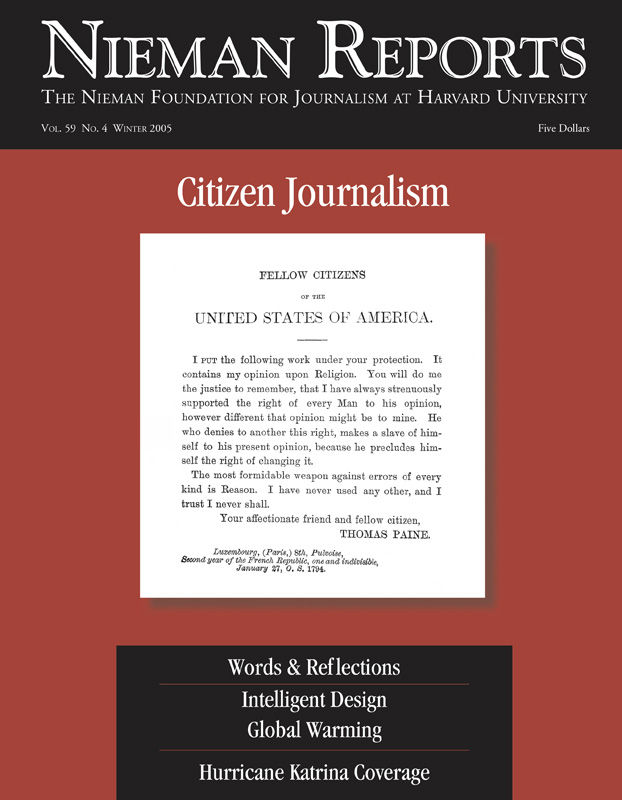The explosions that rocked the London subway system on July 7th transformed the conversation about citizen journalism. Journalists waited at the entrances to a series of subway stations and were able to interview, photograph and video shaken survivors as they emerged from the tunnels. But how were we and other news organizations to get images and accounts of what was happening deep underground?
At The Associated Press headquarters in New York, we saw a dramatic grainy image on a BBC Web site of people being led out of a darkened tunnel deep underground. The photograph had been taken by a commuter on his cell phone. Contacting the commuter, we obtained rights to the photograph, which we then distributed on our service and which was, despite the borderline image quality, widely used on the front pages of newspapers and Web sites around the globe.
This was citizen journalism in action.
With recent technical advances in cell-phone technology, many of them now produce acceptable quality still images (and video) and have the potential to become a new, relatively untapped source of visual journalism. In the age of the Web and e-mail, these images can be rapidly e-mailed across the globe and published. While the news industry has used citizen-produced photographs and film in the past—the Kennedy assassination, for example—we have never experienced the volume of content that is now at our fingertips.
No longer is the conversation in journalism about whether we are going to use citizen-produced material, but how we are going to use it. Most importantly, whatever we do decide to use must meet our editorial standards.
There are issues, of course:
Once these issues have been addressed to everyone’s satisfaction, there is no reason why citizens cannot offer their perspectives on global events. Of course, the challenge will be finding ways in our newsrooms to sift through the millions of images that people take on their cell-phone cameras every day and to determine what meets the standards of journalism.
Santiago Lyon, a 2004 Nieman Fellow, is director of photography for The Associated Press. Lou Ferrara is online editor for The Associated Press.
At The Associated Press headquarters in New York, we saw a dramatic grainy image on a BBC Web site of people being led out of a darkened tunnel deep underground. The photograph had been taken by a commuter on his cell phone. Contacting the commuter, we obtained rights to the photograph, which we then distributed on our service and which was, despite the borderline image quality, widely used on the front pages of newspapers and Web sites around the globe.
This was citizen journalism in action.
With recent technical advances in cell-phone technology, many of them now produce acceptable quality still images (and video) and have the potential to become a new, relatively untapped source of visual journalism. In the age of the Web and e-mail, these images can be rapidly e-mailed across the globe and published. While the news industry has used citizen-produced photographs and film in the past—the Kennedy assassination, for example—we have never experienced the volume of content that is now at our fingertips.
No longer is the conversation in journalism about whether we are going to use citizen-produced material, but how we are going to use it. Most importantly, whatever we do decide to use must meet our editorial standards.
There are issues, of course:
- Quality: Image quality and content quality are very important. In the case of the London bombing photograph, the news value outweighed the quality issue, but this will not always be the case. Professional photojournalists will often do a better job recording a news event than citizens because they are trained and better equipped. The citizen element will emerge most strongly when no journalists are present.
- Veracity: How do we know what we are seeing is true? Determining that the images show what the photographer says they show is crucial. In an era in which digital alteration of images is increasingly easy, credibility is everything. The same journalistic standards that are currently applied to mainstream media sources will need to be applied to all citizen-produced material. Verification is crucial.
- Rights: Who can use the images? Media organizations will have to issue the relevant legal language so that the amateur photographer understands what distribution rights they are agreeing to. This will need to be done, probably electronically, before citizen images are distributed.
- Compensation: What are the images worth? Generally a middle ground is reached between what the photographer demands and what the market will bear, and that will determine the price. These details need to be agreed upon before any of these images are distributed.
Once these issues have been addressed to everyone’s satisfaction, there is no reason why citizens cannot offer their perspectives on global events. Of course, the challenge will be finding ways in our newsrooms to sift through the millions of images that people take on their cell-phone cameras every day and to determine what meets the standards of journalism.
Santiago Lyon, a 2004 Nieman Fellow, is director of photography for The Associated Press. Lou Ferrara is online editor for The Associated Press.



